Discover the meaning of behavioral targeting and the benefits you gain from this strategy. This guide will also teach you how behavioral targeting works and the methods you can use for your marketing
Conventional advertising may appear like a trial-and-error experience in the current digitized era.
Before the transition, well-crafted promotional messages failed to convert prospects to customers even after following all the rules.
These undesirable consequences often happen when created ads do not address the target audience’s desires and concerns.
With advanced marketing strategies, business owners can now use data management techniques to reach the right target and effectively motivate them to buy.
The new approach is referred to as behavioral targeting.
What Is Behavioral Targeting?
Behavioral targeting is also referred to as online behavioral advertising.
Behavioral targeting is an approach that allows companies to display marketing promotions and ads to the audience.
Behavioral targeting is based on their browsing and shopping activities.
The procedure involves collecting data from different sources based on prospective clients’ web-browsing.
This compiled information helps brands to create relevant ads to the user’s definite interests and tendencies.
Then, they convey promotional messages to a market that has shown interest in the brand.

Companies need to compile the client’s web searches, buy histories, and commonly visited sites for a successful process.
From the information gathered, businesses may develop a user profile.
The user profile reveals what the audience purchases, desires, and avoids buying.
The technique is an advantage not only to the advertiser but also to the consumers.
They’ll receive a personalized form of targeted advertising, explicitly created for them.
For instance, one may browse for a specific product on the search engine and leave it at that without making a purchase.
Later, the consumer may relate notice ads on their online feeds as a reminder of their previous interest.
Now that you understand behavioral targeting, below are some of the data used to help you determine your audience’s behavior.
Search Term
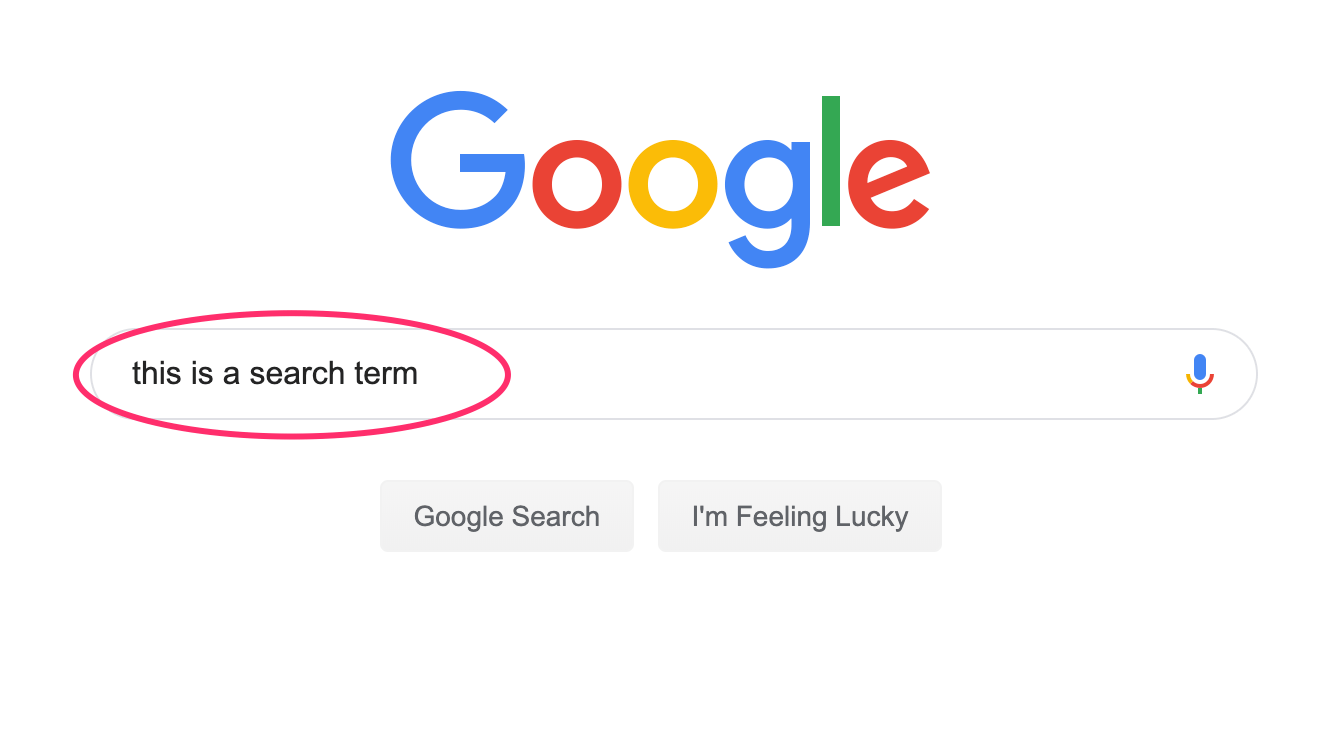
When looking for something in the search engine, one enters a phrase or word to get the desired information.
This action is referred to as the search term or search query.
It is a process that reveals the specific needs of your online audience.
Suppose a prospective client goes to your site and searches for a particular product.
In that case, your data management platform (DMP) uses the recorded data to offer interrelated targeted ads to them in the future.
Some organizations also combine the documented search queries with other data.
Together, they develop a conclusive profile about consumers’ behavior and online activity objectives.
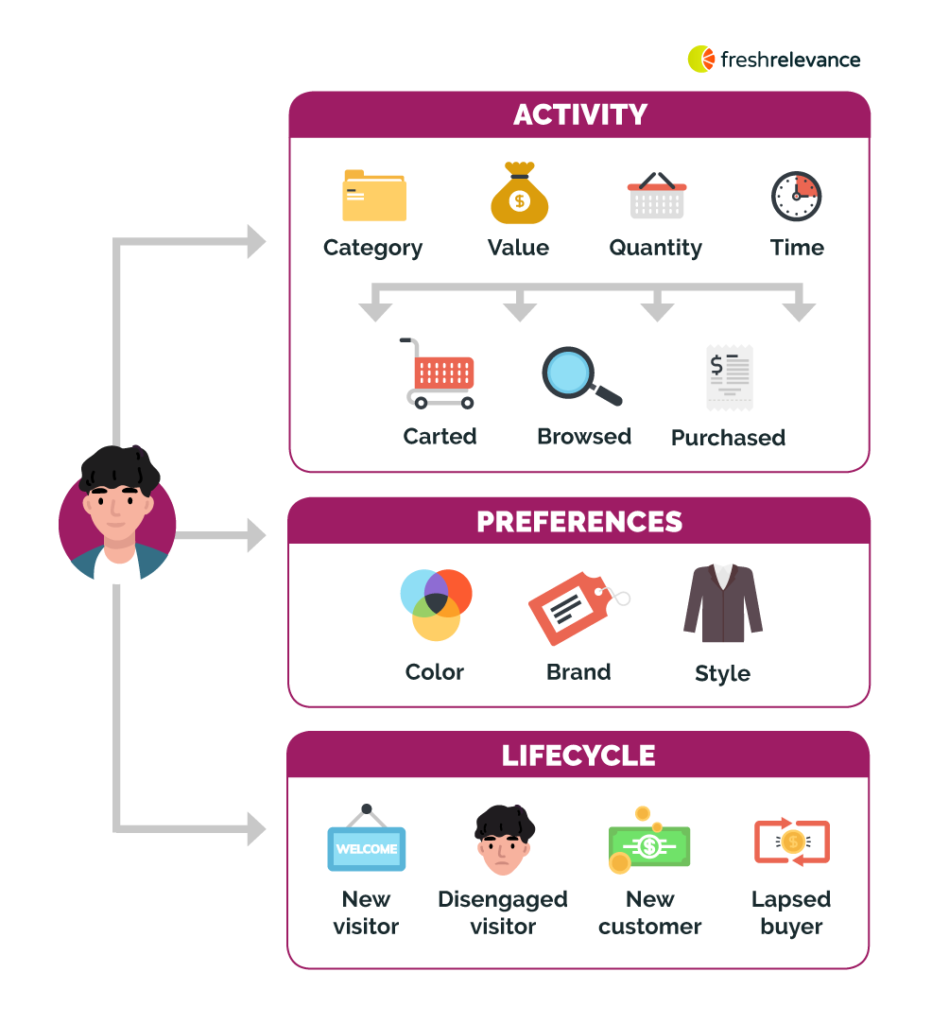
Frequently Visited Sites
Another effective way to determine your audience’s behavior is by using the DMPs to monitor the pages they access.
A proper assessment should scrutinize whether one has visited a site once or on a regular business.
Perusing through these pages may also reveal the customer’s interest trends and behaviors.
The primary purpose of using a DMP is to understand why the audience visited your site.
If your client buys a product from your website, the data may forecast another purchase from you later.
As a result, an organization may use the data collected to develop a targeted advertisement approach for each consumer.
Duration Spent on Each Site

The period spent on a particular site is a vital element in analyzing a consumer’s interest level.
Some online users may click on your link and briefly go through your page before pressing exit.
Others may spend a considerable time reading through your entire site content.
A reliable DMP should not concentrate on URLs only.
Instead, it should focus on the length of time spent on a page as well.
If a business settles on either of them, the DMPs may give inaccurate information affecting the targeted advertising effectiveness.
Sites User Interaction
Web search goals differ from one user to the other.
The easiest way to identify with your consumer’s needs is to identify the elements that attract them to your site.
Note that clients concentrate more on a specific portion of your web content that meets their browsing goals.
Some of these areas in your location may include the video content, navigational sidebars, blog posts, graphics, and others.
The importance of DMPs is to create automatic conclusions that convey messages to the audience effectively.
Links and Ads Clicks
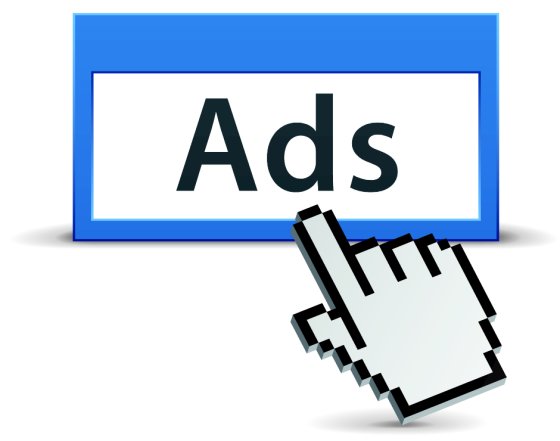
One effective targeted advertising strategy is to grab your audience’s attention through ads or promotional materials.
The results are more purposeful if you monitor the clicks made by your consumers on the site links.
Clicking on a link displays the user goals and the kind of products they are interested in or the advertising messages that attract them to your site.
Remember that some consumers click on a site for leisure purposes or to seek entertainment.
Others have a specific need at hand and are on a mission to get solutions.
Thus, it is essential to understand the diversity between each consumer to develop effective campaigns for all.
The Primary Benefits of Behavioral Targeting
1. Improves Campaign Effectiveness
The primary advantage is that you do not have to spend lots of revenue on irrelevant adverts.
Targeted advertising meets the client’s needs, which instantly motivates them not to seek solutions elsewhere.
For that reason, it may boost sales, increase brand presence, and successfully meet the campaign’s objectives.
2. Advances An Organization’s ROI
The success of any business is to enjoy good returns from the investments made.
A low return on investment (ROI) signifies that you are spending a lot of money on your company without receiving gains.
When your targeted advertisement manages to garner more clicks, it may translate to more profits on your end.
Behavior targeting is steadily picking up in the advertising arena.
However, it cannot appear to all the consumers in your target audience.
The good thing is that it may interest the audience in the advanced sales funnel position and possibly convert them to customers.
3. Increase Sales

Every organization must monitor the activities within its site and the consumer’s behaviors on it.
Through the DMPs, one may view the audience page visits, most preferred content, popular sections, etc.
When an organization manages to compile such vital information, it becomes easier to understand their most successful marketing strategies and vice versa.
The approach guides marketers on offering correct sales techniques to the right audience and accurately.
4. Heighten Engagement With Users
To enhance your relationship with your audience, you need to walk in their shoes and understand why they purchase your product.
A data-driven approach helps an organization gauge consumers’ behavior and identify with the marketing campaigns that effectively convert leads.
5. More Click-Through Rate And Conversion Rates
One of the major advantages of behavioral targeting is the direct relationship between an organization and the audience.
With increased online competition, an organization requires an upgraded approach to stand out amongst others.
There are several sites out there that target a similar audience simultaneously.
A targeted advertising approach simplifies the equation.
Companies will develop campaigns meant for a market that has already shown an interest in a particular product.
That way, it is easier for the audience to click more through your site links as they look for solutions.
The strategy translates to effortless conversion, less marketing/advertising budget, and a better ranking on the search engines.
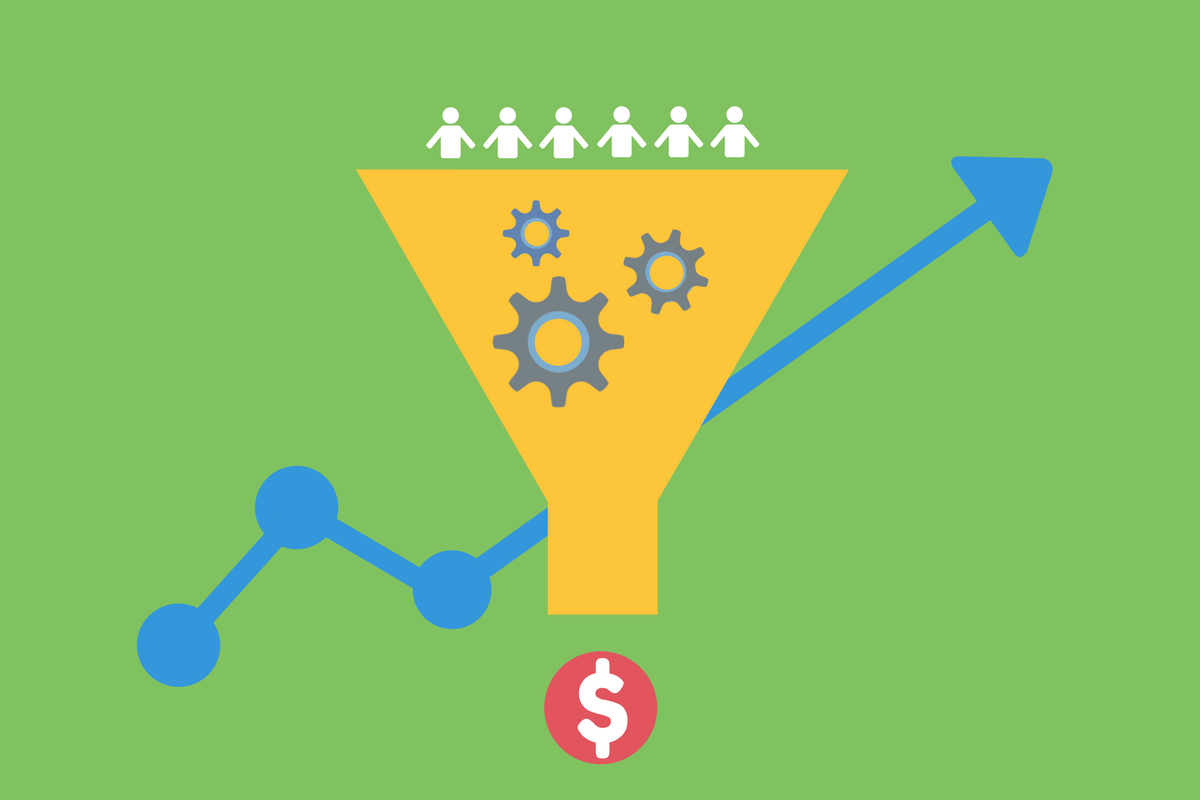
SEO success revolves around your site’s popularity and the number of page views.
That means that if your site has more clicks, it may result in a higher SEO ranking.
However, you need to incorporate that with the right choice of keywords for more fulfilling results.
With targeted advertising focusing on a similar audience, businesses need to find effective strategies to stand out.
A related keyword plays the trick by explaining the content on a page and helping marketers write about the best topics.
Therefore, identifying related keywords helps catch the search engines’ attention while improving your conversion and click rates.
There are various ways you can use to search for related keywords.
One of the most efficient platforms to use is BiQ Keyword Intelligence.
Here, you get winning keywords together with essential insights such as searchers’ intent and the volume of people searching for similar keywords.
The image below shows the results of related keywords and search intent of the term “behavioral targeting.”
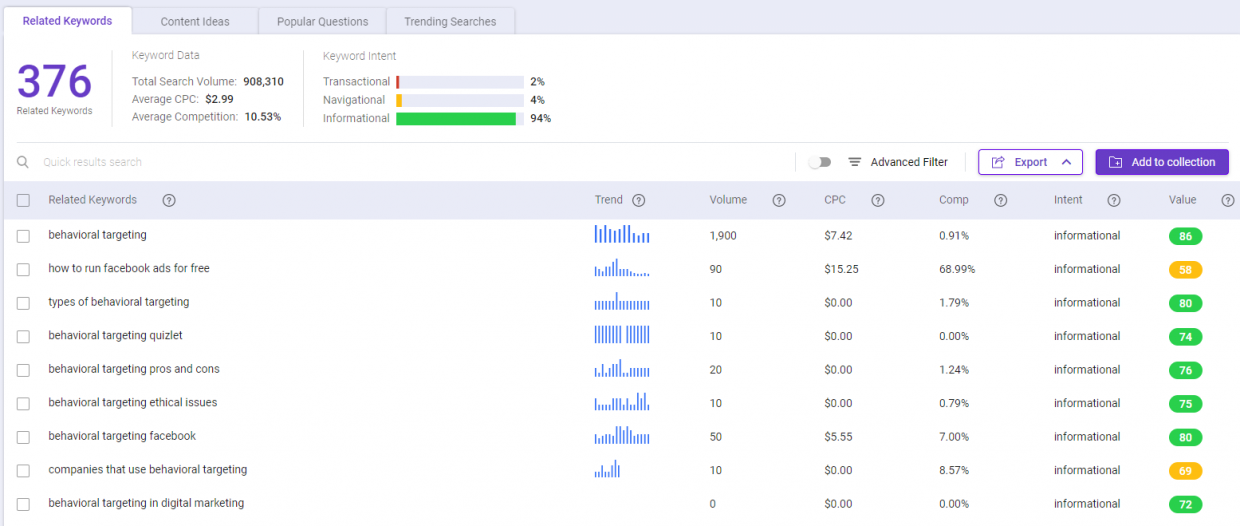
BiQ also shows a wide variety of keywords with their average cost per click value.
If you get confused about the best keyword to use, sort the keywords based on their value.
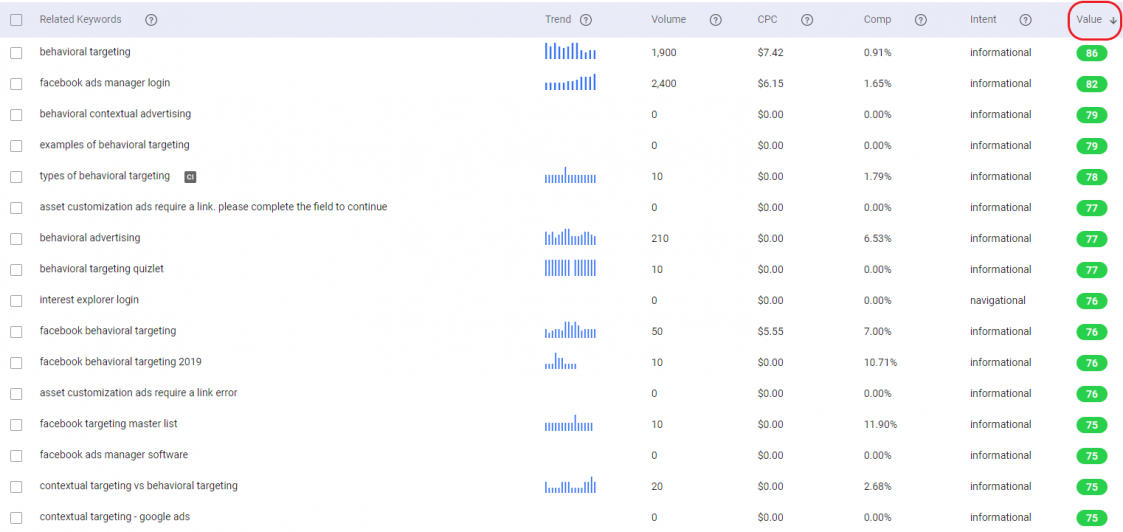
Then, select the higher valued keywords as they have a higher potentiality of attracting more traffic to your site.
Note that even if you get an appealing keyword, you need to complement it with winning content that surpasses others.
BiQ Content Intelligence guides online users on how to craft an exciting piece of content.
Through an effortless process, the platform analyzes the best performing organic content on search engines.
Additionally, it gives a list of keywords in terms of similarity and usage.
How Does Behavioral Targeting Work
You need to do behavioral targeting right for a more rewarding experience.
These three steps define a successful process of behavioral targeting.
Step 1: Data Analysis and Collection
There are several sources that an entrepreneur may collect the much-needed data beneficial to adverts crafting.
Most companies use tracking pixels or cookie tracking to collect data and then accumulate it in a DMP.
From the piled-up data, one may analyze and use it to develop user segments.
Pixel tracking is a procedure that uses a pixel gif to monitor a website page, event, or a guest visit.
On the other hand, cookie tracking refers to text files used on browsers to compile specific user data.
Some of the data collected include consumer preferences, purchases done, geographical area, browsing activity, among others.
Step 2: Information Segmentation and Organization
Once you have compiled enough data in the first stage, sort your users into segments that share similar behaviors.
An organization’s groupings may differ depending on a brand, goals, and products.
For instance, if you run a spa parlor, you may categorize your segments based on monthly visits, audience interest with SEO, and others.
Step 3: Data Application in Advertising Promotions
Behavioral targeting concentrates on crafting campaigns for each segment created.
The process elevates advertising to more extraordinary lengths by enhancing the chances of audience engagement and increasing conversions.
Behavioral Targeting Methods
Cross-selling and Upselling
Recognizing your audience’s needs is a powerful way to understand which other products you can introduce to them.
The purpose of this strategy is to engage the audience for different campaigns.
For example, if your company manufactures toothpaste, you can raise a toothbrush campaign to harmonize the entire advertising process.
That way, you manage to satisfy your audience’s needs while increasing returns for your business.
Behavioral Targeting and Personalized Email Campaign
Based on how consumers use your site, a personalized email approach may increase your productivity and targeting alternatives.
According to a recent study, there is a 56.68% chance of increasing your email open rates by using a targeted approach.
You can create a specific email campaign for those who abandoned the purchasing process halfway or on the search engine terms.
Geographical Based Targeting

This is a brilliant technique of engaging audiences based on how they have visited your shop or stores.
The method also applies to online stores and eCommerce guest visits.
With geo-targeted ads, you can personalize ads to target specific locations.
These ads are often effective.
A study by Verve discovered that geo-targeted ads yield an average of 50% higher conversion as compared to non-targeted ads.
Present Personalized Offers, Discounts and Coupons
Discounts and offers help a business to increase sales, brand awareness, and effectively retain clients.
The disadvantage of using this technique is that every sales increase may not translate to profits.
Don’t forget that discounts take a considerable chunk from the full price.
Targeted groups may avert this by giving an average percentage of the loss incurred in a metric referred to as discount sensitivity.
Through the process, organizations may employ new strategies on the targeted groups for an enhanced response rate.
Likewise, the techniques should focus on increasing revenue for a brand while avoiding giving excessive discounts.
Conclusion
Advertising remains a focal point in the success of any business.
Firms are focusing more on online presence and a better SEO ranking.
But there is a need for an advanced approach that focuses on campaign effectiveness.
There is no other better way of achieving this but through behavioral targeting.
The technique may not interest everybody in your target market.
But it helps organizations create personalized campaigns based on consumer behavior.
As a result, the approach may easily convert prospects into loyal clients.




